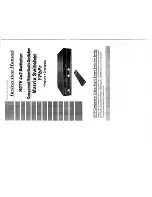
EKI-9500 Series User Manual
260
4.6.1.2
Port Summary
Use the Port Access Control Port Summary page to view summary information about
the port-based authentication settings for each port.
To access this page, click
Security
>
Port Access Control
>
Port Summary
.
Figure 4.287 Security > Port Access Control > Port Summary
The following table describes the items in the previous figure.
Monitor Mode
The administrative mode of the Monitor Mode feature on the device.
Monitor mode is a special mode that can be enabled in conjunction
with port-based access control. Monitor mode provides a way for net-
work administrators to identify possible issues with the port-based
access control configuration on the device without affecting the net-
work access to the users of the device. It allows network access even
in cases where there is a failure to authenticate, but it logs the results
of the authentication process for diagnostic purposes. If the device fails
to authenticate a client for any reason (for example, RADIUS access
reject from the RADIUS server, RADIUS timeout, or the client itself is
802.1X unaware), the client is authenticated and is undisturbed by the
failure condition(s). The reasons for failure are logged and buffered
into the local logging database for tracking purposes.
EAPOL Flood Mode The administrative mode of the Extensible Authentication Protocol
(EAP) over LAN (EAPOL) flood support on the device. EAPOL Flood
Mode can be enabled when Admin Mode and Monitor Mode are dis-
abled.
Submit
Click
Submit
to save the values and update the screen.
Refresh
Click
Refresh
to update the screen.
Cancel
Click
Cancel
to restore default value.
Item
Description
Item
Description
Interface
The interface associated with the rest of the data in the row.
PAE Capabilities
The Port Access Entity (PAE) role, which is one of the following:
Authenticator: The port enforces authentication and passes
authentication information from a remote supplicant (similar to a
client or host) to the authentication server. If the server success-
fully authenticates the supplicant, the port allows access.
Supplicant: The port must be granted permission by the authenti-
cation server before it can access the remote authenticator port.
















































